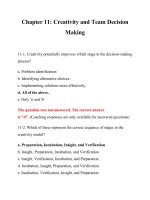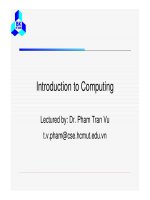Organizational behavior: Lecture 11 - Dr. Mukhtar Ahmed
Bạn đang xem bản rút gọn của tài liệu. Xem và tải ngay bản đầy đủ của tài liệu tại đây (340.06 KB, 37 trang )
Organizational
Behavior
(MGT-502)
Lecture-11
Summary
of
Lecture-10
• What is Perception?
– A process by which individuals organize
and interpret their sensory impressions in
order to give meaning to their
environment.
• Why Is it Important?
– Because people’s behavior is based on
their perception of what reality is, not on
reality itself.
– The world that is perceived is the world
that is behaviorally important.
Factors Influencing
Perception
• The Perceiver
• The Target
• The Situation
Factors that Influence Perception
Factors
Factorsininthe
thesituation
situation
••Time
Time
••Work
Worksetting
setting
••Social
Socialsetting
setting
Factors
Factorsininthe
thePerceiver
Perceiver
••Attitudes
Attitudes
••Motives
Motives
••Interests
Interests
••Experience
Experience
••Expectations
Expectations
Perception
Perception
Factors
Factorsininthe
thetarget
target
••Novelty
Novelty
••Motion
Motion
••Sounds
Sounds
••Size
Size
••Background
Background
••Proximity
Proximity
Today’s Topics
Perception, Attitudes,
and Personality
Attitudes
Perception
Behavior
Personality
Person Perception:
Making Judgments
about others
Attribution
The Process through which
individuals attempt to
determine the causes of others
behavior
The “Causes”
• Assigning a cause helps to make sense of
initial behavior
• Was the behavior a real desire or was it from
outside pressure??
• Internal (personality, motives) causes
• External (other people, situation)
causes
Attributions - Consequences
• Subsequent
behaviors
• Emotions
• Feelings
• Attitudes
The Attribution Process
•Information
•Beliefs
•Motivation
•Perceived external
or internal causes
of behavior
•Behavior
•Feelings
•Expectations
Attribution Theory
Attribution theory - explains how
individuals pinpoint the causes of their
own behavior or that of others
Information cues for attribution information
gathering
– consensus
– distinctiveness
– consistency
Person Perception: Making
Judgments About Others
• Distinctiveness: Shows different
behaviors in different situations.
• Consensus: Response is the same as
others to same situation.
• Consistency: Responds in the same
way over time.
Observation
Interpretation
Attribution
of Cause
High
External
Low
Internal
High
External
Low
Internal
High
External
Low
Internal
Distinctiveness
Attribution
Theory and
Individual
Consensus
Behavior
Consistency
Kelley’s Theory of Causal
Attribution
The approach suggesting that
people will believe others actions
to be caused by internal or
external factors.
Fundamental Attribution Error
The tendency to attribute others’
actions to internal causes (e.g their
traits) while largely ignoring external
factors that also may have influenced
their behavior.
Self-Serving Bias
–The tendency for individuals
to attribute their own
successes to internal factors
while putting the blame for
failures on external factors.
Frequently Used Shortcuts in
Judging Others
• Selective Perception
– People selectively interpret what they see on the basis of their
interest, background, experience, and attitudes.
• Halo Effect
– A general impression about an individual is based on a single positive
characteristic.
• Contrast Effects
– Evaluations of a person’s characteristics that are affected by
comparisons with other people recently encountered who rank
higher or lower on the same characteristics.
• Projection
– Attributing one’s own characteristics to other people
• Stereotyping
– Judging someone on the basis of the group to which he/she belongs.
Specific Applications in
Organizations
• Employment Interview
– Perceptual biases affect the accuracy of interviewers’ judgments of
applicants.
• Performance Expectations
– Self-fulfilling prophecy: A situation in which one person inaccurately
perceives a second person and the resulting expectations cause the
second person to behave in ways consistent with the original
perception.
• Performance Evaluations
– Appraisals are subjective perceptions of performance.
• Employee Effort
– Assessment of individual effort is a subjective judgment subject to
perceptual distortion and bias.
Perception and
Performance Appraisal
• Objective and Subjective Measures
– Higher in the organizational hierarchy, it
becomes more difficult to find objective
measures or quantifiable evidence to use to
measure performance.
– Therefore, organizations rely on subjective
measures of effectiveness provided by
managers.
Rater Errors
• Leniency – The tendency to perceive
the job performance of ratees as
especially good.
• Harshness – The tendency to perceive
the job performance of ratees as
especially ineffective.
• Central tendency – The tendency to
assign most ratees to middle-range job
performance categories.
• Halo effect – The rating of an
individual on one trait or characteristic
tends to colour ratings on other traits or
characteristics.
• Similar-to-me effect – A rater gives
more favourable evaluations to people
who are similar to the rater in terms of
background or attitudes.
Misperception
Misperception is the cognitive
process by which an individual
selects and organizes, but
misinterprets, environmental
stimuli.









